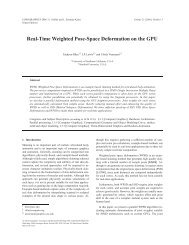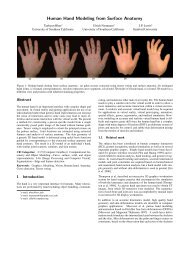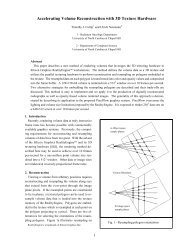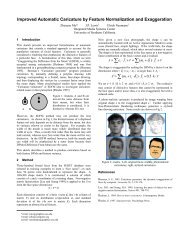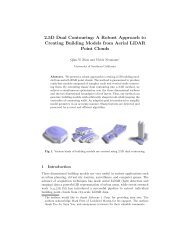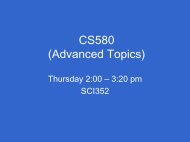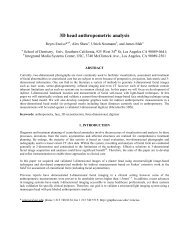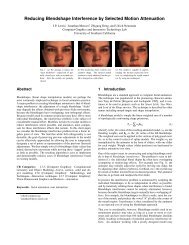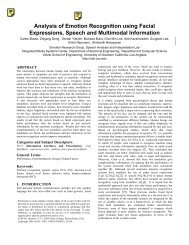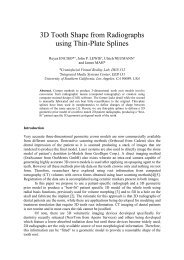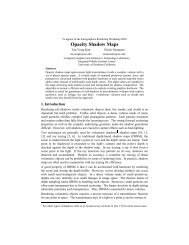Audio-based Head Motion Synthesis for Avatar-based Telepresence ...
Audio-based Head Motion Synthesis for Avatar-based Telepresence ...
Audio-based Head Motion Synthesis for Avatar-based Telepresence ...
Create successful ePaper yourself
Turn your PDF publications into a flip-book with our unique Google optimized e-Paper software.
Prediction Coefficient). These 31 dimensional audio feature<br />
vectors are reduced to four dimensions using Principal<br />
Component Analysis (PCA), covering 98.89% of the variation.<br />
An audio feature PCA space expanded by four eigenvectors<br />
(corresponding to the four largest eigen-values) is<br />
also constructed. Note that which audio features enclose<br />
most useful in<strong>for</strong>mation <strong>for</strong> head motion estimation is still<br />
an open question, and audio features used <strong>for</strong> this work are<br />
chosen experimentally.<br />
In this way, a database of aligned audio-head-motion is<br />
constructed (Fig 2). For simplicity, AHD (<strong>Audio</strong>-<strong>Head</strong>motion<br />
Database) is used to refer to this database in the remaining<br />
sections. Each entry of the AHD is composed of a four dimensional<br />
audio feature PCA coefficients (AF-COEF) and<br />
a head motion trans<strong>for</strong>mation vector (T-VEC). Note that<br />
the AHD is indexed by the AF-COEF.<br />
Figure 2: Illustration of the <strong>Audio</strong>-<strong>Head</strong>motion<br />
Database (AHD). Each entry in this database is<br />
composed of two parts: a AF-COEF (four dimensional<br />
audio feature pca coefficients) and a T-VEC<br />
(six dimensional head motion trans<strong>for</strong>mation vector).<br />
4. SYNTHESIZING HEAD MOTION<br />
After the AHD is constructed (Section 3), the audio features<br />
of a given novel speech input are reduced into AF-<br />
COEFs by projecting them into the audio feature PCA space<br />
(Eq. 1) created in Section 3. Here F is a 31 dimensional<br />
audio feature vector, f is its AF-COEF, and M is the eigenvector<br />
matrix (31*4 in this case).<br />
f = M T .(F − ¯ F ) (1)<br />
Then, these AF-COEFs are used to index the AHD and<br />
search <strong>for</strong> their K nearest neighbors. After these neighbors<br />
are identified, a dynamic programming technique is used to<br />
find the optimum nearest neighbor combination by minimizing<br />
the total cost. Finally, the head motion of the chosen<br />
nearest neighbors is concatenated together to <strong>for</strong>m the final<br />
head motion sequence. Figure 3 illustrates this head motion<br />
synthesis pipeline.<br />
4.1 Find K-Nearest Neighbors<br />
Given an input (inquiry) AF-COEF q, its nearest K neighbors<br />
in the AHD are located. In this case, K (the number<br />
of nearest neighbors) is experimentally set to 7 (Section 5).<br />
The euclidean distance is used to measure the difference<br />
between two AF-COEFs (Eq. 2). Here d represents a AF-<br />
COEF of an entry in the AHD. In this step, this distance<br />
(termed neighbor-distance in this paper) is also retained.<br />
<br />
<br />
<br />
dist = 4 <br />
(qi − di) 2 (2)<br />
i=1<br />
Numerous approaches were presented to speed up the Knearest<br />
neighbor search, and a good overview can be found<br />
in [25]. In this work, KD-tree [26] is used to speed up this<br />
search. The average time complexity of a KD-tree search is<br />
O(log Nd), where Nd is the size of the dataset.<br />
4.2 Dynamic Programming Optimization<br />
After PCA projection and K nearest neighbors search, <strong>for</strong><br />
a AF-COEF fi at time Ti, its K nearest neighbors are found<br />
(assume its K nearest neighbors are Ni,1, Ni,2, . . . , Ni,K).<br />
Which neighbor should be optimally chosen at time Ti? A<br />
dynamic programming technique is used here to find the optimum<br />
neighbor combination by minimizing the total “synthesis<br />
cost” (“synthesis error” and “synthesis cost” are used<br />
interchangablely in this paper).<br />
The synthesis cost (error) at time Ti is defined to include<br />
the following three parts:<br />
• Neighbor-distance Error (NE): the neighbor-distance<br />
(Eq. 2) between the AF-COEF of a nearest neighbor,<br />
e.g. ci,j, and the input AF-COEF fi (Eq. 3).<br />
NEi,j = ci,j − fi2<br />
(3)<br />
• Roughness Error (RE): represents the roughness of the<br />
synthesized head motion path. Smooth head motion<br />
(small RE) is preferred. Suppose Vi−1 is the T-VEC<br />
at time Ti−1 and T Vi,j is the T-VEC of j th nearest<br />
neighbor at time Ti. When the j th neighbor is chosen<br />
at time Ti, REi,j is defined as the second derivative at<br />
time Ti as follows (Eq. 4):<br />
REi,j = T Vi,j − Vi−12<br />
(4)<br />
• Away Keyframe Error (AE): represents how far away<br />
the current head pose is from specified key head pose.<br />
<strong>Head</strong> motion toward specified key head poses decreases<br />
the AE. Suppose KP is the next goal of key head pose<br />
at time Ti and Pi−1 is the head pose at time Ti−1, then<br />
AEi,j is calculated (Eq. 5).<br />
AEi,j = KP − (Pi−1 + T Vi,j)2<br />
If the j th neighbor is chosen at time Ti and Wn, Wr, and<br />
Wa (assume Wn ≥ 0,Wr ≥ 0, Wa ≥ 0, and Wn + Wr +<br />
Wa = 1) are the weights <strong>for</strong> NE, RE and AE respectively,<br />
the synthesis error erri,j (when the j th nearest neighbor is<br />
chosen at time Ti) is the weighted sum ofthe above three<br />
errors (Eq. 6).<br />
erri,j = Wn.NEi,j + Wr.REi,j + Wa.AEi,j<br />
Since the decision made at time Ti only depends on the<br />
current K neighbor candidates and the previous state (e.g.<br />
the head pose) at time Ti−1, a dynamic programming technique<br />
is used to solve the optimum nearest neighbor combination.<br />
Suppose ERRi,j represents the accumulated synthesis error<br />
from time T1 to Ti when j th neighbor is chosen at time<br />
Ti; P AT Hi,j represents the chosen neighbor at time Ti−1<br />
when the j th neighbor is chosen at time Ti. Further assume<br />
(5)<br />
(6)


